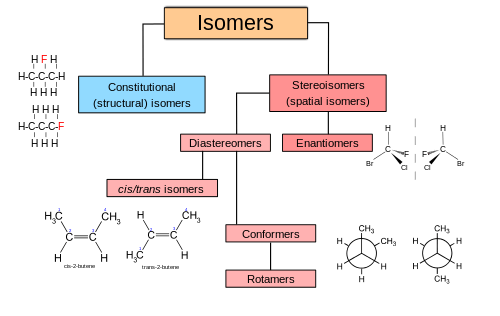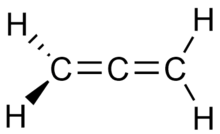Isomer
An isomer (/ˈaɪsəmər/; from Greek ἰσομερής, isomerès; isos = "equal", méros = "part") is a molecule with the same molecular formula as another molecule, but with a different chemical structure. That is, isomers contain the same number of atoms of each element, but have different arrangements of their atoms.[1][2] Isomers do not necessarily share similar properties, unless they also have the same functional groups. There are two main forms of isomerism (/ˈaɪsəmərɪzm/ or /aɪˈsɒmərɪzm/): structural isomerism (or constitutional isomerism) and stereoisomerism (or spatial isomerism).
Structural isomers

In structural isomers, sometimes referred to as constitutional isomers, the atoms and functional groups are joined together in different ways. Structural isomers have different IUPAC names and may or may not belong to the same functional group.[3] This group includes chain isomerism whereby hydrocarbon chains have variable amounts of branching; position isomerism, which deals with the position of a functional group on a chain; and functional group isomerism, in which one functional group is split up into different ones.
For example, two position isomers would be 2-fluoropropane and 1-fluoropropane, illustrated on the left side of the diagram above.
In skeletal isomers the main carbon chain is different between the two isomers. This type of isomerism is most identifiable in secondary and tertiary alcohol isomers.
Tautomers are structural isomers of the same chemical substance that spontaneously interconvert with each other, even when pure. They have different chemical properties and, as a consequence, distinct reactions characteristic to each form are observed. If the interconversion reaction is fast enough, tautomers cannot be isolated from each other. An example is when they differ by the position of a proton, such as in keto/enol tautomerism, where the proton is alternately on the carbon or oxygen.
Example: propanols and methoxyethane
A simple example of isomerism is given by propanol: It has the formula C3H8O (or C3H7OH) and occurs as two isomers: propan-1-ol (n-propyl alcohol; I) and propan-2-ol (isopropyl alcohol; II)

Note that the position of the oxygen atom differs between the two: It is attached to an end carbon in the first isomer, and to the center carbon in the second.
There is, however, another isomer of C3H8O that has significantly different properties: methoxyethane (methyl-ethyl-ether; III). Unlike the isomers of propanol, methoxyethane has an oxygen connected to two carbons rather than to one carbon and one hydrogen. Methoxyethane is an ether, not an alcohol, because it lacks a hydroxyl group, and it has chemical properties more similar to other ethers than to either of the above alcohol isomers.
Example: propadiene and propyne
Propadiene (or allene) and propyne (or methylacetylene) are examples of isomers containing different bond types. Propadiene contains two double bonds, whereas propyne contains one triple bond.
 Propadiene |
 Propyne |
Stereoisomers
In stereoisomers the bond structure is the same, but the geometrical positioning of atoms and functional groups in space differs. This class includes enantiomers, which are non-superimposable mirror-images of each other, and diastereomers, which are not. Enantiomers always contain chiral centres and diastereomers often do, but there are some diastereomers that neither are chiral nor contain chiral centers.[4] Another type of isomer, conformational isomers (conformers), may be rotamers, diastereomers, or enantiomers depending on the exact compound. For example, ortho- position-locked biphenyl systems have enantiomers.
E/Z isomers, which have restricted rotation within the molecule, to be specific isomers containing a double bond, are configurational isomers. They are classified as diastereomers, whether or not they contain any chiral centres.[4] E/Z notation depicts absolute stereochemistry, which is an unambiguous descriptor based on CIP priorities.
"Cis–trans isomers" are used to describe any molecules with restricted rotation in the molecule. For molecules with C=C double bonds, these descriptors describe relative stereochemistry only based on group bulkiness or principal carbon chain, and so can be ambiguous. This is especially problematic for double bonds that have more than two substituents. An obsolete term for cis–trans isomerism is "geometric isomerism".[5] For alkenes with more than two substituents, E-Z notation is used instead of cis and trans. If possible, E and Z (written in italic type) is also preferred in compounds with two substituents.[6]

Cis and trans isomers also occur in inorganic coordination compounds, such as square planar MX2Y2 complexes and octahedral MX4Y2 complexes. A related type of geometric isomerism is facial–meridional (fac-mer) isomerism in octahedral MX3Y3 complexes, in which each set of three identical ligands either occupies one face of the octahedron or is situated on one meridian of the octahedron.
Note that, although conformers can be referred to as stereoisomers, they are not stable isomers, since bonds in conformers can easily rotate, thus converting one conformer to another, which can be either diastereomeric or enantiomeric to the original one.
While structural isomers typically have different chemical properties, stereoisomers behave identically in most chemical reactions, except in their reaction with other stereoisomers. Enzymes, however, can distinguish between different enantiomers of a compound, and organisms often prefer one isomer over the other. Some stereoisomers also differ in the way they rotate polarized light.
Isomerization
Isomerization is the process by which one molecule is transformed into another molecule that has exactly the same atoms, but the atoms are rearranged.[7] In some molecules and under some conditions, isomerization occurs spontaneously. Many isomers are equal or roughly equal in bond energy, and so exist in roughly equal amounts, provided that they can interconvert relatively freely, that is the energy barrier between the two isomers is not too high. When the isomerization occurs intramolecularly, it is considered a rearrangement reaction.
An example of an organometallic isomerization is the production of decaphenylferrocene, [(η5-C5Ph5)2Fe] from its linkage isomer.[8][9]
Synthesis of fumaric acid
Industrial synthesis of fumaric acid proceeds via the cis-trans isomerization of maleic acid:
Medicinal chemistry
Examples of isomers having different medical properties can be easily found. For example, in the placement of methyl groups. In substituted xanthines, theobromine, found in chocolate, is a vasodilator with some effects in common with caffeine; but, if one of the two methyl groups is moved to a different position on the two-ring core, the isomer is theophylline, which has a variety of effects, including bronchodilation and anti-inflammatory action. Another example of this occurs in the phenethylamine-based stimulant drugs. Phentermine is a non-chiral compound with a weaker effect than that of amphetamine. It is used as an appetite-reducing medication and has mild or no stimulant properties. However, a different atomic arrangement gives dextromethamphetamine, which is a stronger stimulant than amphetamine.
In medicinal chemistry and biochemistry, enantiomers are a special concern because they may possess quite different biological activity. Many preparative procedures afford a mixture of equal amounts of both enantiomeric forms. In some cases, the enantiomers are separated by chromatography using chiral stationary phases. They may also be separated through the formation of diastereomeric salts. In other cases, enantioselective synthesis have been developed.
As an inorganic example, cisplatin (see structure above) is an important drug used in cancer chemotherapy, whereas the trans isomer (transplatin) has no useful pharmacological activity.
History
Isomerism was first noticed in 1827, when Friedrich Woehler prepared silver cyanate and discovered that, although its elemental composition was identical to silver fulminate (prepared by Justus von Liebig the previous year),[10] its properties were quite different. This finding challenged the prevailing chemical understanding of the time, which held that chemical compounds could be different only when they had different elemental compositions. After additional discoveries of the same sort were made, such as Woehler's 1828 discovery that urea has the same atomic composition as the chemically distinct ammonium cyanate, Jöns Jacob Berzelius introduced the term isomerism in 1830 to describe the phenomenon.[11]
| The fulminate ion consists of the atoms C, N, and O arranged with N as the middle atom that is bound to each of the other two. | |
| In comparison, the cyanate ion consists of the atoms N, C, and O arranged with C as the middle atom that is bound to each of the other two. |
In 1848, Louis Pasteur separated tartaric acid into tiny crystals of its two mirror-image forms.[12][13] The individual molecules of each were the left and right optical stereoisomers, solutions of which rotate the plane of polarized light to the same degree but in opposite directions.
Other types of isomerism
Other types of isomerism exist outside this scope. In general, topological isomers called topoisomers are large molecules that wind about and form different-shaped knots or loops. Molecules with topoisomers include catenanes and DNA. Topoisomerase enzymes can knot DNA and thus change its topology. There are also isotopomers or isotopic isomers that have the same numbers of each type of isotopic substitution but in chemically different positions. In nuclear physics, nuclear isomers are excited states of atomic nuclei. Spin isomers have differing distributions of spin among their constituent atoms.
See also
- Chirality (chemistry)
- Cis-trans isomerism
- Cyclohexane conformation
- Electromerism
- Ligand isomerism
- Nuclear isomer
- Stereocenter
- Structural isomerism
- Tautomer
- Vitamer
References
- ↑ Petrucci R.H., Harwood R.S. and Herring F.G. "General Chemistry" (8th ed., Prentice-Hall 2002), p. 91
- ↑ The word "isomer" was coined by Swedish chemist Jöns Jacob Berzelius (1779–1848) in 1830. See: Jac. Berzelius (1830) “Om sammansättningen af vinsyra och drufsyra (John’s säure aus den Voghesen), om blyoxidens atomvigt, samt allmänna anmärkningar om sådana kroppar som hafva lika sammansättning, men skiljaktiga egenskaper” (On the composition of tartaric acid and racemic acid (John's acid of the Vosges), on the molecular weight of lead oxide, together with general observations on those bodies that have the same composition but different properties) Kongliga Svenska Vetenskaps Academiens Handling (Transactions of the Royal Swedish Science Academy), vol. 49, pages 49–80; see especially page 70. Reprinted in German in: J.J. Berzelius (1831) “Über die Zusammensetzung der Weinsäure und Traubensäure (John's säure aus den Voghesen), über das Atomengewicht des Bleioxyds, nebst allgemeinen Bemerkungen über solche Körper, die gleiche Zusammensetzung, aber ungleiche Eigenschaften besitzen," Annalen der Physik und Chemie, vol. 19, pages 305–335; see especially page 326. Reprinted in French in: J.J. Berzelius (1831) “Composition de l’acide tartarique et de l’acide racémique (traubensäure); poids atomique de l’oxide de plomb, et remarques générals sur les corps qui ont la même composition, et possèdent des proprietés différentes,” Annales de Chimie et de Physique, vol. 46, pages 113–147; see especially page 136.
- ↑ Smith, Janice Gorzynski (2010). General, Organic and Biological Chemistry (1st ed.). McGraw-Hill. p. 450. ISBN 978-0-07-302657-2.
- 1 2 Ernest L. Eliel and Samuel H. Wilen, Stereochemistry of Organic Compounds(Wiley Interscience 1994), pp.52-53
- ↑ IUPAC definition of geometric isomerism
- ↑ IUPAC definition of cis and trans
- ↑ IUPAC, Compendium of Chemical Terminology, 2nd ed. (the "Gold Book") (1997). Online corrected version: (2006–) "isomerization".
- ↑ Brown, K. N.; Field, L. D.; Lay, P. A.; Lindall, C. M.; Masters, A. F. (1990). "(η5-Pentaphenylcyclopentadienyl){1-(η6-phenyl)-2,3,4,5-tetraphenylcyclopentadienyl}iron(II), [Fe(η5-C5Ph5){(η6-C6H5)C5Ph4}], a linkage isomer of decaphenylferrocene". J. Chem. Soc., Chem. Commun. (5): 408–410. doi:10.1039/C39900000408.
- ↑ Field, L. D.; Hambley, T. W.; Humphrey, P. A.; Lindall, C. M.; Gainsford, G. J.; Masters, A. F.; Stpierre, T. G.; Webb, J. (1995). "Decaphenylferrocene". Aust. J. Chem. 48 (4): 851–860. doi:10.1071/CH9950851.
- ↑ F. Kurzer (2000). "Fulminic Acid in the History of Organic Chemistry". J. Chem. Educ. 77 (7): 851–857. Bibcode:2000JChEd..77..851K. doi:10.1021/ed077p851.
- ↑ Esteban, Soledad. (2008). "Liebig–Wöhler Controversy and the Concept of Isomerism". J. Chem. Educ. 85 (9): 1201. Bibcode:2008JChEd..85.1201E. doi:10.1021/ed085p1201.
- ↑ L. Pasteur (1848) "Mémoire sur la relation qui peut exister entre la forme cristalline et la composition chimique, et sur la cause de la polarisation rotatoire" (Memoir on the relationship which can exist between crystalline form and chemical composition, and on the cause of rotary polarization)," Comptes rendus de l'Académie des sciences (Paris), vol. 26, pages 535–538.
- ↑ L. Pasteur (1848) "Sur les relations qui peuvent exister entre la forme cristalline, la composition chimique et le sens de la polarisation rotatoire" (On the relations that can exist between crystalline form, chemical composition, and the sense of rotary polarization), Annales de Chimie et de Physique, 3rd series, vol. 24, no. 6, pages 442–459.
External links
| Wikiquote has quotations related to: Isomer |
| Wikimedia Commons has media related to Isomerism. |
